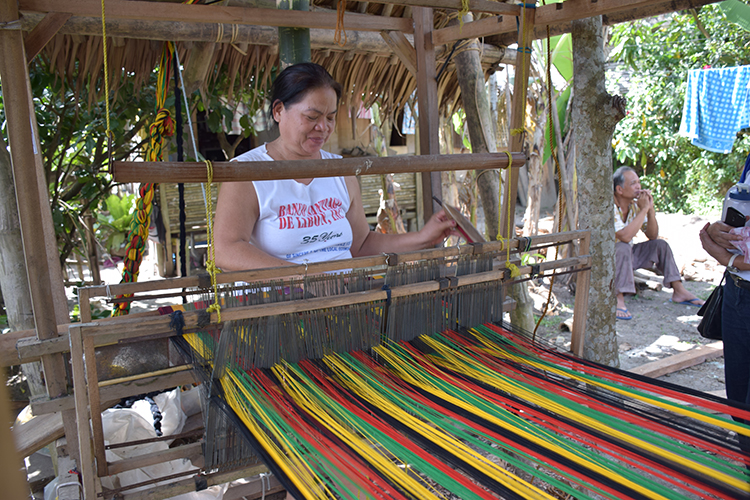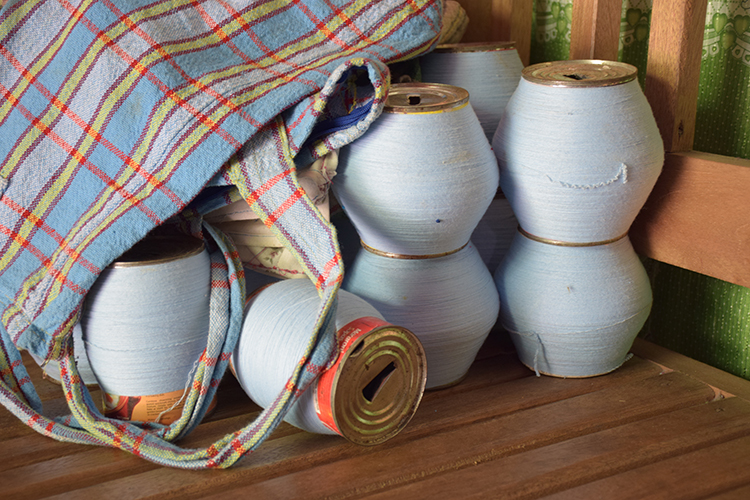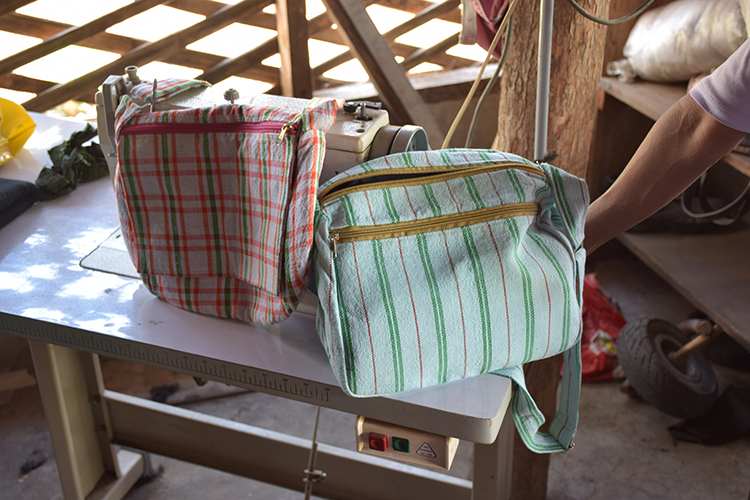In 2013, the Buhi OTOP Key Players of BOKPA was among the first to be identified and qualified as SSF beneficiary. Through the cooperation of the Caceres Social Foundation, a church-based organization, the weavers became the happy, grateful and appreciative recipients of 40 handlooms and 6 sewing machines, which they need to produce and earn more.
Since the award, the weavers in Buhi maximized the use of handlooms. Every time DTI visits, all handlooms have work in progress and spindles are always busy spinning. Since it is home-based, all household members are working together to produce “hinabol”. The converters are all busy trading the products in the region, especially in the growth areas, while others are waiting at home for the regular buyers to pick-up their blankets.
To the women of Buhi, handloom weaving is an age-old skill. Historically, handloom weaving used to be the locals’ way of producing clothes out of abaca fiber, which is converted into the traditional “baro’t saya”, “kamisa”, mosquito net and even underwear. The hinabol was also used as a strainer for rice flour that is used in making local delicacies.
The use of cotton thread from scrap t-shirt collars from factories in Manila was introduced to the local weavers in the 70’s and the town of Buhi became known as a major inces and they reach as far as Visayas and Mindanao. Its popularity waned in the early ‘90s where the presence of department stores were felt in the countryside and people were provided with many other alternatives.
This being the case, the traditional handloom weaving in many parts of the region became extinct but never in Buhi. According to the weavers we interviewed, their lives will not be complete without weaving, so they are here to stay.
The Buhi weavers were among the clusters in the wearables and homestyle sector being assisted by DTI-Camarines. The support was more concretized and focused when it was chosen as the OTOP of Buhi. The active weavers of the group were organized, now named Buhi OTOP Key Players Association. Since then, the group was provided with an outpouring assistance from the department.
Conversion of the “hinabol” into other products aside from blanket was developed in the area and several MSMEs were developed. They were able to produce a variety of products through the help of DTI’s series of product development seminars. Since then, the group was given the rare opportunity to join trade fairs not only in the region, but also in Metro Manila. However, lack of equipment were among their concerns, hence the provision of the Shared Service Facility to the BOKPA was well appreciated by the group.
“We could not imagine a life without weaving because weaving is our life, so weaving is here to stay. We love weaving, this is us, this is our heritage, this is our life. (Buhi weavers)
Life is busy for the handloom weavers in the quaint town of Buhi. The homes are alive with twirls and colors of the threads and fabrics, people are happy and contented, tradition is preserved.
Mala-uyay is now in business
Susan Abad is a young grandmother. She used to be a tailor in Manila who came back to Buhi to raise her family. Although a skilled sewer, she was not able to use her skills fully because of lack of opportunities in Buhi.
She weaved blankets like the others
Because her neighbors are into weaving, she also learned the craft and became a weaver and sold her products as blankets as the norm in the town. There was a time in June, when her daughter was already in high school and she has no money to buy a school bag, she made a bag for her daughter from her “hinabol”
Then she made bags
When her daughter came home after the first day of classes, she reported that she reported that she doesn’t have a bag anymore because her teacher bought it and she ordered 3 more. From them on, she made bags out of her woven fabrics and sold the same in town.
She said that she became so passionate with bags, that when she sees a new design, she would not stop until she examined it carefully and imagined how it was done. Among the bestseller bags in Buhi is a knapsack that looks like a shoe. She said that she’s the first one who made it in hinabol fabric.
An electricity bill collector came one day wearing a shoe-like bag. She got excited with its novel look so she asked the man if she could have it copied by giving the bag to her because she has to redo it in order to make a new one. Luckily, the man is generous enough to give her the bag on the condition that when she makes a bag like it, she should make one for him, too.
And the shoe bag became a hit
The bill collector received his hinabol shoe bag because Susan sold hundreds of shoe bags and many other converters have copied it too, making it a bestseller among their products. That’s why she was chosen to a recipient of a zigzag sewing machine through the SSF project of DTI, and she has a beautiful story to tell.
The seminar kit challenge
She said that the SSF paved a significant part in her life, testing her talents, capability, ability and all other aspects in her life, and she was so happy of the experiences as many proved her as a person. When SSF came in October 2013, it was housed at the Parish Hall of Buhi as a communal facility for the converters. However, to them it was not workable because they have to spend more time and money before they can use it, since it is very far from her place, which is a remote part of the town. So, the facility was nothing to her, but she is aware that they can use it and that it is for them.
Sometime in March 2014, she was asked to go to Legazpi by DSWD to a project that at first she did not understand well, so she reluctant to go. She is very mindful of the money she has to spend for the fare. Nevertheless, she took heed of the call because she does not want to disappoint the personnel from DSWD who invited her to come. Because of her reluctance, she arrived lunchtime, though she has to be there at 9:00 A.M. What happened in Legazpi was something she could not forget. She got an order that she has never dreamt of, 1,500 pieces of seminar kits made of hinabol fabrics, which she has to deliver in 1 1/5 months!
Though afraid and could not believe for herself, she accepted the challenge. Upon her return, she immediately went to some weavers whom she believed could deliver the hinabol fabrics. She also pleaded to the cooperator to release the machines to her and to the other members of the group so they could supply the order.
She said that it was a great opportunity for her and the group for without the SSF, they would not be able to come up with the orders, since they don’t have the means to do it. She said that it was a baptism of fire and should another opportunity come, she and her group are ready to take the challenge.
While waiting for another opportunity, she is regularly producing wallets and bags for her regular buyers. She is very thankful for the sewing machine that helped them a lot, especially in their livelihood. Also, she thanks the many government assistances and support that they received that made their lives more challenging, and a result improved their quality of life.
Her success can be seen by the metamorphosis of her house and she always wears a smile every time we make a visit. Come, Mala-uyay is in business! (Mala-uyay is the name she calls her products, which means beautiful in Buhi-non)
A New Dawn Arises for the Lavapies
Julie Lavapie is a housewife who stays at home and works at a neighbor’s handloom for livelihood. Life is hard for her and her family and they could hardly have both ends meet.
Julie is among the women identified to be a beneficiary of the SSF handloom project in Buhi. Her heart overflows with happiness and gratitude for this gift because at last, she has her own handloom.
After receiving the handloom, she immediately assembled it and started working on it. Day and night she weaves, and soon, all of her family members, including her husband are weaving. They can produce more than 6 blankets a day.
After 3 months, they were able to buy another handloom and now, they have a total of 4 handlooms. She has to extend her humble house in order to house all the handlooms. The converters are her major buyers, since they want to deal with the Lavapies because they can immediately produce their requirements as 5 members of the family are working together.
The Lavapies is one big happy family and are very thankful for being one of the beneficiaries of DTI’s SSF project. Each member of the family earns and their lives improved because of SSF.





